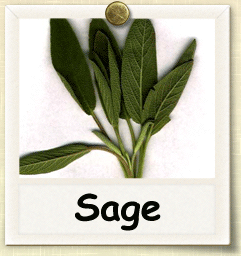|
Home > Guides > Herbs > Sage |
|
How to Grow Sage | Guide to Growing Sage |
|
|
| |
 |
|
Overview |
|
|
|
|
|
| |
|
| |
Sage is for more than seasoning your Thanksgiving turkey. Harvest fresh leaves from your kitchen garden to flavor meat and bean dishes, or toss the blossoms into salad! You can even wire dried sprigs to a frame to create an aromatic wreath or swag. |
|
| |
|
|
| |
Growing Guide
GROWING NOTES
Use Fresh Seed. Does not store well.
Thrives in full sun.
Replace after a few years.
Prefers well drained soil.
MAINTAINING
You can start seed indoors up to eight weeks before your last frost date. If you sow seeds right in the garden, do so up to two weeks before the last frost date. Use fresh seed, as it doesn’t store well. You can also start plants from root cuttings from established plants. Set plants or thin seedlings to stand 24 to 30 inches apart. Sage thrives in full sun and well-drained soil. Young plants need a steady moisture supply until they start growing vigorously.
Each spring, prune out the woodiest stems and spent flower stalks. Stop harvesting early in the fall to encourage the plant to harden off for the winter. After a few years, plants become quite woody and less productive. Plan a year ahead to replace them.
|
|
| |
|
| |
|
|
| |
|
|
| |
Harvesting Guide
HARVESTING
Harvest lightly during the first year to allow this perennial plant to become established. In the following couple of years, you may be able to harvest an entire plant two or three times. When harvesting, leave a few stalks in place to allow the plant to rejuvenate.
If you wish to dry sage, hang stalks in a shady, well-ventilated area until the leaves crumble easily, then store in tightly lidded jars. Sage keeps its flavor better if stored in the freezer. Freeze leaves or stalks on a tray, then move the leaves into a zippered bag or container. Some cooks blend the leaves with oil, pack the ground mixture into ice cube trays to freeze, and then transfer the cubes to a container.
SAVING SEEDS
Sage produces seed pods shaped like bells. They turn a dark greyish-brown at maturity and the free ends open wide to allow for seed dispersal.
Remove the individual pods, they come away very easily when mature. Allow the pods to dry for a few days in a warm place. Mature seeds will roll out of the base of the bell. Usually there are only a few seeds in a bell.
|
|
| |
|
|
|
| |
|
|